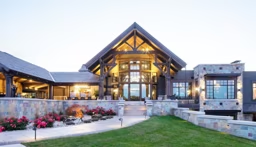Living in a log home immediately connects you to nature as it envelops you in organic warmth and textures. But the logs in your home have a different role than logs out in the woods.
The importance of sealing and protecting a log home properly cannot be overemphasized, even if you prefer a look that is "au natural." If there is any doubt, the value of staining and sealing a log home with the right products becomes apparent once you understand how the elements work to deteriorate both unfinished logs and logs sealed with an ineffective product.

Photo: Courtesy Perma-Chink Systems, Inc.
Familiarizing yourself with what happens to untreated logs can help you make the best decisions for your log home's longevity and good looks. Here's where to start:
Water, Insects, Rot
When water penetrates wood, it can contribute to rot and weakens a log's structural integrity, making it even easier for insects to get into the logs. Moisture in logs also provides an inviting environment for fungi, whose growth will expedite a log's decomposition.If you want to know what could happen to an untreated log home, just look at a forest. Water, insects and fungi prey on living trees and downed logs alike. In nature, each of these plays an important role in turning a log back into soil. That's good news for a forest, but not for your log home.

Photo: Courtesy Perma-Chink Systems, Inc.
The Sun
Another element that is detrimental to log homes is sunlight, or more specifically, the sun's ultraviolet (UV) rays. In dead wood, like those of a log home, wood fibers exposed to UV light oxidize and turn a silvery gray color.
In old log homes, oxidation can appear as a beautiful patina. However, the reality is that this process can take decades to complete, and not all wood receives the same level of UV exposure. Decks and south or western-facing walls will get more UV exposure, while northern walls and logs under covered porches and eaves receive less. As a result, an untreated log home develops an uneven, blotchy appearance that detracts from its beauty.
Long-Lasting Beauty
With all this in mind, it's clear that protecting your logs from the elements is the best way to keep them strong and sturdy and protect them from rot and destruction.
People have different ideas of what is meant by "sealing a home," so it's worth a closer look. Sealing a home can mean caulking and chinking to seal up the cracks between windows, logs and doors.
Sealing also refers to a coating applied to the logs such as a stain, such as Lifeline, which applies the color. Then a top coat, Lifeline Advance, protects the stain, accentuating natural highlights and extending the life of the stain color so a homeowner can do more living and less log home maintenance. Another solution is to use a stain that matches your logs' natural color and enjoy the wood's inherent beauty with the peace of mind of protection. And if you want to avoid the graying process, UV Boost can be used as a first coat on bare wood for enhanced protection.

Photo: Courtesy Perma-Chink Systems, Inc.
But the options don't end there; in the case that a home has been previously stained with an oil, a product like Log & Timber Defense can be a good option.

Photo: Courtesy Perma-Chink Systems, Inc.
Don't Just Treat it, Treat it Right
By now, it's clear that untreated logs are vulnerable to damage. However, even a seemingly sealed log can still be at risk. Many stains and sealants create a coating that is inflexible. This is a problem. Logos are an organic material and therefore shrink and expand with seasonal and daily cycles of hot and cold. The shapeshifting is imperceptible to our eyes, but not to an inflexible covering. Small cracks and micro fissures will develop, creating openings for water to enter. Additionally, many of these inflexible stains cannot breathe. Any moisture that was inside the log when the stain was applied becomes trapped, creating adhesion issues or eventually, rot... The solution? Products that flex. In addition to having particles that penetrate deep into the wood, Perma-Chink Systems stain and topcoat are engineered to be breathable and flexible to remedy both these issues.

Photo: Courtesy Perma-Chink Systems, Inc.
Rest Easy Knowing You're Covered
A little preventative action, like the protective sealing offered by Perma-Chink's System, helps you live out your log home dream. Instead of spending weekends fretting and laboring over your log home's maintenance, you get to relax knowing your logs and your log home lifestyle are protected. That's a look that wears well!
Follow along! Join Perma-Chink Systems, Inc. in this exclusive Ask the Expert series to get answers to all your top questions about staining, sealing, maintenance and more!
Sponsored by Perma-Chink Systems, Inc.











